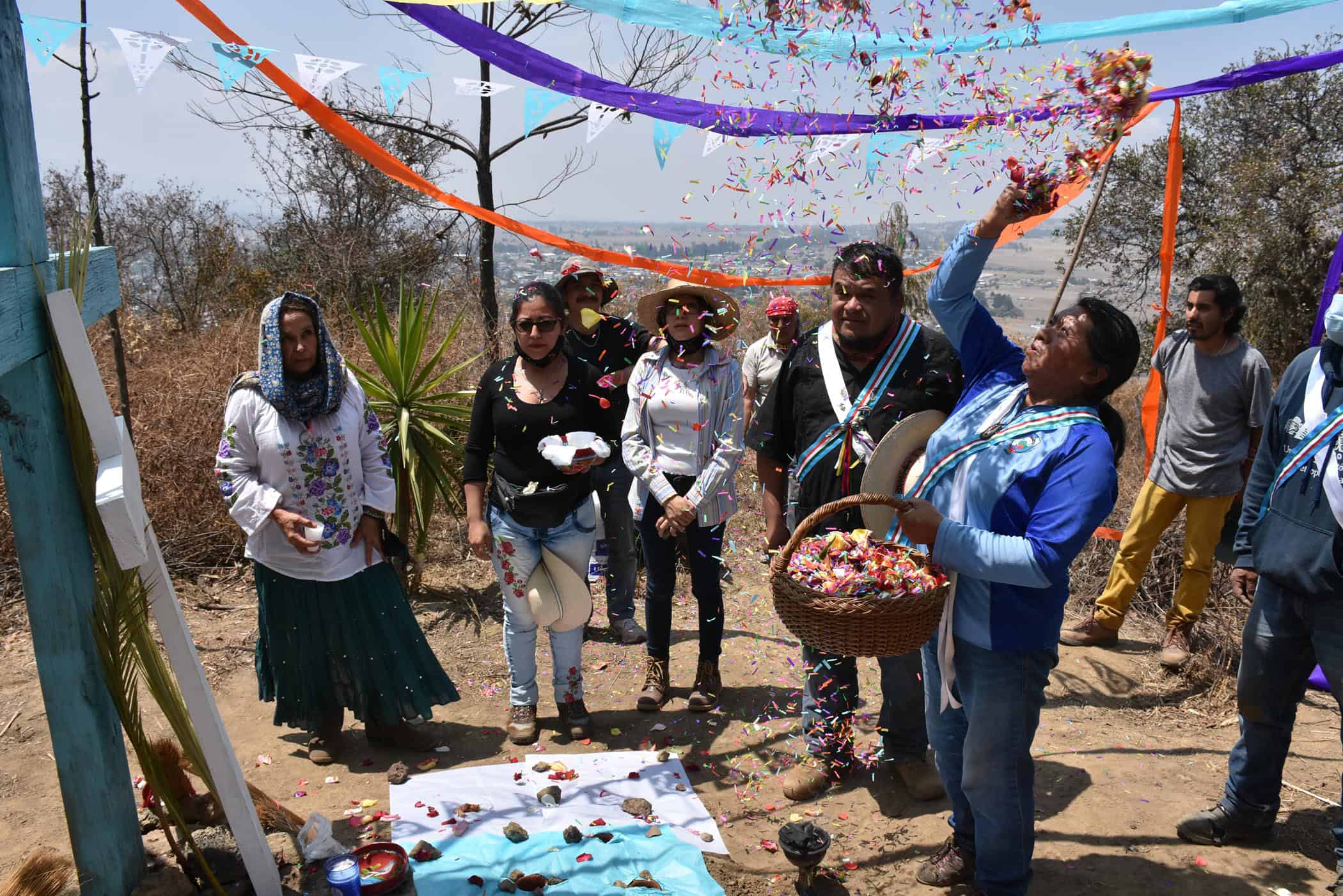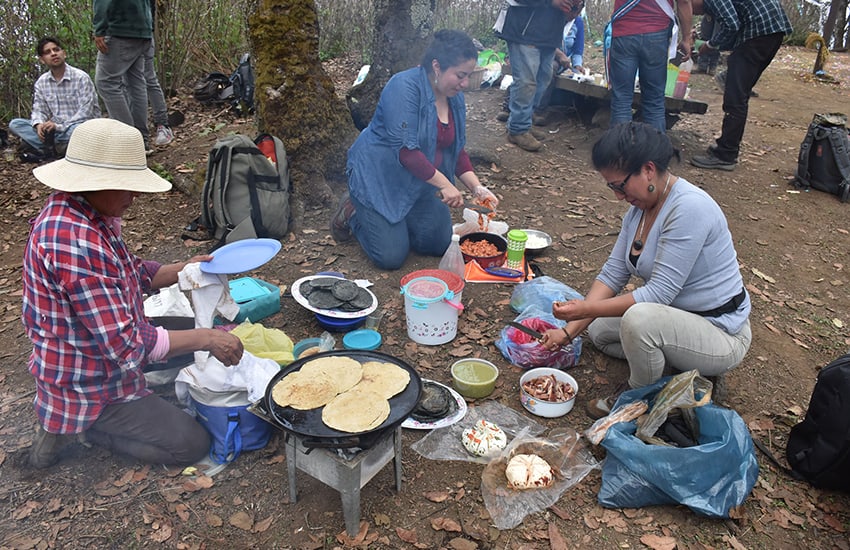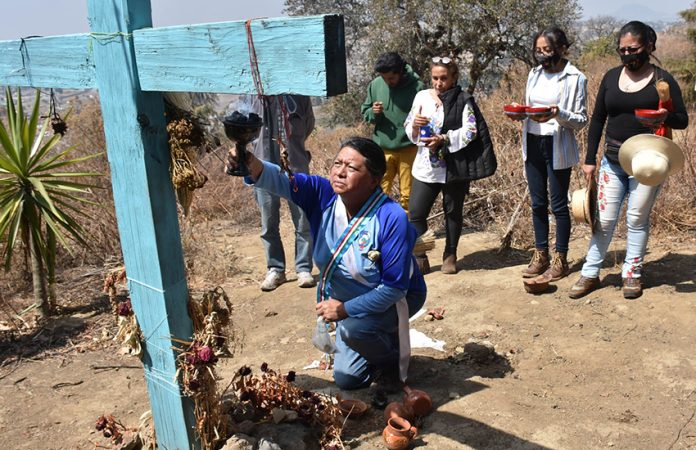We had only traveled a short distance up the narrow, bumpy road toward the top of a sacred hill in México state when Judi asked Javier to stop the car: we needed to ask the volcano in the area to be allowed passage.
“When you enter certain spaces, you need to say a greeting, especially when it is for a ritual,” she said. “One needs to ask permission of nature and of whomever are the owners [spirits] of the space.”
Permission must be asked at other times as well, she explained, even if a person is simply heading to a home on the hill. “One must always ask permission to pass,” she said.
We were heading up that hill to participate in a petición de lluvia — an ancient ritual to ask the spirits for rain. Judi made her request to the volcano, and we continued on.
Rain rituals, which date back thousands of years, are conducted in many pueblos located in the Valley of México and Puebla during the month of May. Many of them are in the Sierra Nevada mountain range and are set near the Popocatépetl and Iztaccíhuatl volcanoes.

The shamans that conduct them are called graniceros and are considered descendants from the line of priests of Tlaloc, the Aztec god of rain.
“They’re called graniceros because, in addition to petitioning for rain, they will perform rituals to drive away hail [granizo], which can destroy crops,” said Javier, who has studied and written about them. “Each granicero has their own prayers and sacred formulas and certain elements that they can use to detour clouds. These ceremonies and rituals have changed very little over many years.”
Graniceros also contact spirits to cure diseases, he said.
After Javier parked the car outside of a fenced-in area and we prepared to head out, Judi handed each of us a lime. “We will be walking through a cemetery,” she said. “The lime will protect us from bad spirits.”
Fourteen people gathered at the foot of the short path that leads up to the cross where the ritual would take place. Before going up, we doused ourselves with agua florida — flowered water made from several herbs. “We put it on so that the bad spirits do not enter us,” said Diego. “It is protection.”
The petition started with the singing of a short song often sung in Catholic churches: “Good morning white dove/Today I come to greet you/ Greeting your beauty/ In your heavenly kingdom.”
“There are ancient elements and Catholic elements,” said Gerardo, the granicero who led the petition.
“For us, Christ is the sun, and the mountain is the Virgin,” Esmeralda, a granicera, added. “For me, it is the same to sing to the Virgin as to Iztaccíhuatl.”
Gerardo then cleansed the cross with incense, and each of us followed in turn.
Three small cups were buried in the ground, and a man named Raymundo placed a mirror nearby, surrounding it with cotton. The cups, which represent hills or mountains, were filled with water and covered with dirt. The mirror reflected — and represented — the sky, and the cotton represented the clouds.
Esmeralda carried a basket filled with confetti and rose petals around the cross, tossing handfuls in the air, evoking the image of a rainbow. The group then set to work cleaning the area and decorating the cross with flowers.
“The white flowers represent the clouds that bring rain,” said Javier, “and the blue ones represent the sky.”
Offerings, including some very specific ones — such as fruits, vegetables, breads, tequila and beer — were then placed around the base of the cross.
“What we dream, we bring,” said Jeimi. “For example, I brought fruits and bread because via the dreams, this is what they asked me for.”
Graniceros believe that the dreams are sent by volcanoes. “Everyone in this area believes that all nature has spirits,” Javier said, “the mountains, the caves, the volcanoes.”
Once the offerings were placed, the graniceros stood in front of the cross, holding small bowls filled with water. Gerardo led them in a short ritual, after which they tossed the water into the air, mimicking rainfall. Then we had to leave.
“We descend so that the spirits can eat alone,” said Diego. “We will eat apart, and then we will [return] to share the food and drink with them.”
An hour later, after a large meal under a tree, we returned to the site to consume the offerings there with the spirits — but not all the offerings.

“There are foods we should not take because the volcanoes appeared to people in dreams told them what they wanted,” Diego said. “And so, for example, Judi was told to bring vegetables, and the other woman was told to bring sweets and rice and mole and meat, which is exclusive for [the spirits].”
A granicero took a large bottle of warm beer, shook it and sprayed foam on the remaining offerings and the cross. This, too, was to mimic rain falling.
After an hour, it was time to leave the ritual area again. Gerardo performed a ceremony to ask the spirits to return to their proper places. “The doors to the other world are closed,” he said.
We descended to continue eating, drinking tequila, and enjoying conviviencia (gathering together).
These rituals aren’t cultural artifacts, something done simply for show. Graniceros and many people in this region deeply believe that they’re critically important.
“It will still rain around the world because there are many who do this,” Gerardo said, explaining that it’s a commitment he makes. “If we do not complete this, the spirits will punish us … like [by making us] sick or not feel well.”
“This ceremony is important so that it rains and so that we don’t forget the land,” Esmeralda said. “It is said that the graniceros make it rain, but no. They are in the service of the lords of water, and they [the spirits] decide if they give us water or not. We only bring what they ask us.”
It’s clear that a ritual like this builds and strengthens community and connects people with a past that goes back millennia. It also teaches respect for the planet.
If a person believes, as several participants told me, that everything — mountains, rivers, volcanoes — has a spirit, it’s much more difficult to pollute or destroy them. And, graniceros and participants firmly believe, the ritual brings rain. Who’s to say that it doesn’t?
The weather forecast for the area had predicted a 25% chance of rain that day. As we stood sipping tequila and talking under a tree after the ceremony, it began to rain.
“El señor is sending the rain we asked for,” said Jeimi.
• Gerardo and other graniceros and participants were very kind and open about their beliefs, allowing me to photograph and interview without restrictions, asking only that I not identify the location of the petitions or use full names. Some names have also been changed. —JS
Joseph Sorrentino, a writer, photographer and author of the book San Gregorio Atlapulco: Cosmvisiones and of Stinky Island Tales: Some Stories from an Italian-American Childhood, is a regular contributor to Mexico News Daily. More examples of his photographs and links to other articles may be found at www.sorrentinophotography.com He currently lives in Chipilo, Puebla.
